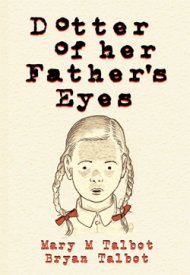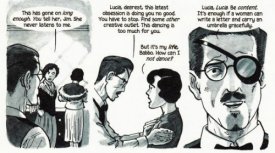
A biography and an autobiography all in one. Sort of. Mary M. Talbot is the daughter of James S Atherton, eminent Joyce scholar and author of the much acclaimed The Books at the Wake: A Study of Literary Allusions in James Joyce's Finnegans Wake and Bryan Talbot, who kindly provided the illustrations to Dotter of Her Father's Eyes, is her husband.
Mary M. Talbot compares her childhood to that of James Joyce's daughter Lucia (1907 - 1982), both fathers are preoccupied with writing and appear to have increasingly less time for their daughters. Whereas Talbot turns out rather well - she is a scholar whose published works deal with "language, gender, and power", and she is, presumably, happily married - Lucia Joyce's childhood and later life are not quite as happy. Not much about her early life is known - though many speculations exist - born in Trieste, Italy she lived a far from stable life (the Joyce's are known to have moved house and country a lot, due to the war(s) as well as financial difficulties) which can't have been beneficial to her aspirations to become a professional dancer. In the 1930s her mental health started to deteriorate and she was eventually admitted as a patient by Carl Jung.
My issue with the account of Lucia Joyce's life in this novel is that the author relies heavily on Carol Schloss's Lucia Joyce: To Dance in the Wake (2003). Schloss argues that Lucia was Joyce's muse for Finnegans Wake and, more important, that her mental state was at least partially caused by her mother, Nora Joyce. In Dotter of her Father's Eyes Nora is portrayed as someone who cared very little about her daughter's happiness which is then related to the time in which she grows up when sons were still regarded as much more important, and perhaps valuable, than daughters. I can see how Lucia's ambitions as a dancers may have been thwarted - partially - by both her parents who didn't think that a career outside the home was something for young women to aspire to at all. However, the mother-daughter relationship, to me, is nothing more than conjecture and speculation as neither Talbot nor Schloss would know how exactly Nora Joyce treated her daughter. Plus, I can't imagine her to be this evil sort of woman who doesn't care much about her daughter at all:

I am giving this book
 , mostly for the illustrations and Talbot's writing about her own life. I am not quite so enthusiastic about her account of Lucia Joyce's childhood.
, mostly for the illustrations and Talbot's writing about her own life. I am not quite so enthusiastic about her account of Lucia Joyce's childhood.

